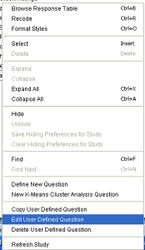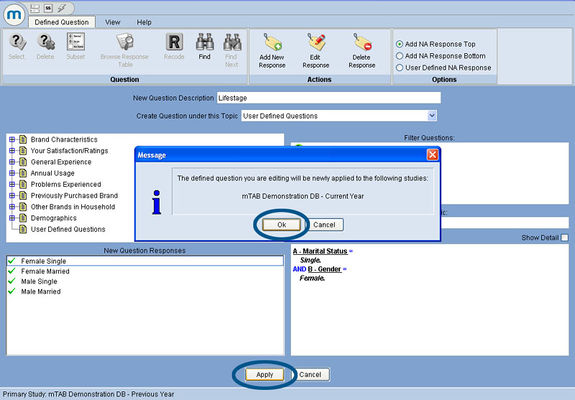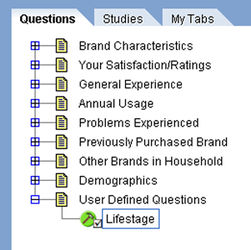Difference between revisions of "Applying a user defined question to another study"
| Line 1: | Line 1: | ||
| − | This article includes the necessary steps to apply an existing User Defined Question (UDQ) to another study. Please refer to | + | This article includes the necessary steps to apply an existing User Defined Question (UDQ) to another study. Please refer to [[User Defined Questions Overview]] assistance with Creating a User Defined Question. |
Revision as of 13:51, 25 July 2013
This article includes the necessary steps to apply an existing User Defined Question (UDQ) to another study. Please refer to User Defined Questions Overview assistance with Creating a User Defined Question.
Benefit
To save a significant amount of time, a single User Defined Question (UDQ) can be applied to other waves or years of a study. This eliminates the additional work of creating separate UDQs for each year of a particular study. An example of how Applying a UDQ to Another Study is used would be to create one UDQ for the 2010 Buyer Study and apply the same UDQ to the 2009, 2008, and 2007 versions of the study.
Instructions
Start by loading a study with an existing UDQ. This is the Primary Study. Note: At least one UDQ should exist in the study. If not, create one before proceeding. Refer here for instructions on creating UDQs.
Next, select Layer and select the Multiple Studies option. Go to the Available Studies list on the left window pane of mTAB. Find the study or studies that the existing UDQ should be applied to and either double-click or drag them into Layer.
In the following example, an existing UDQ was created for the study named, “mTAB Demonstration DB – Previous Year.” This is the Primary Study. The UDQ will be applied to the study named, “mTAB Demonstration DB – Current Year.”
The User Defined Question icon will appear red. A red UDQ means that it is available for one of the loaded studies, but not the other. Proceed with the next steps to apply the UDQ to all studies that have been loaded in Layer.
Right-click on the UDQ and select Edit User Defined Question from the menu.
The User Defined Questions window will open. Make a note of the New Question Responses, located at the bottom left. There will either be green check marks or red ‘X’s next to each of the question responses. Green check-marks mean that the original base questions that the New Question Responses were built from have not changed between the studies and the process of Applying the UDQ to other studies can proceed.
If the New Question Responses have red X’s instead of green check marks, refer to this supplemental article before proceeding. This article explains how to make the red question responses green and suitable for updating.
If there are no red X’s or if the red X’s have been changed to green check marks by following the steps in the preceding link, continue by clicking the Apply button.
A message window will appear stating that the UDQ will be applied to another study. Click OK to proceed.
The following window may or may not appear as an option, depending on each mTAB user’s options. If an mTAB user has the option to save a Group resource, such as a Saved Tab, Recode, User Defined Question, etc., the following window will appear. Choose whether to save this as a ‘Private’ or a ‘Group’ UDQ.
The UDQ will be saved and applied to another study. Scroll down to the User Defined Questions topic. The UDQ should now be green. Include the green UDQ in a tab and run it by hitting the lightning bolt. mTAB will now display data for each study that is currently loaded.



